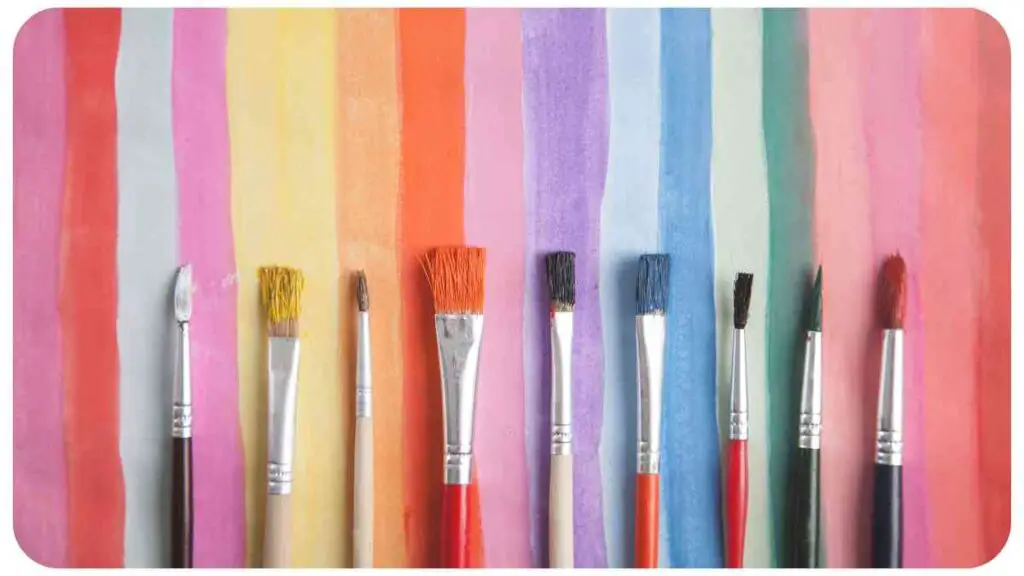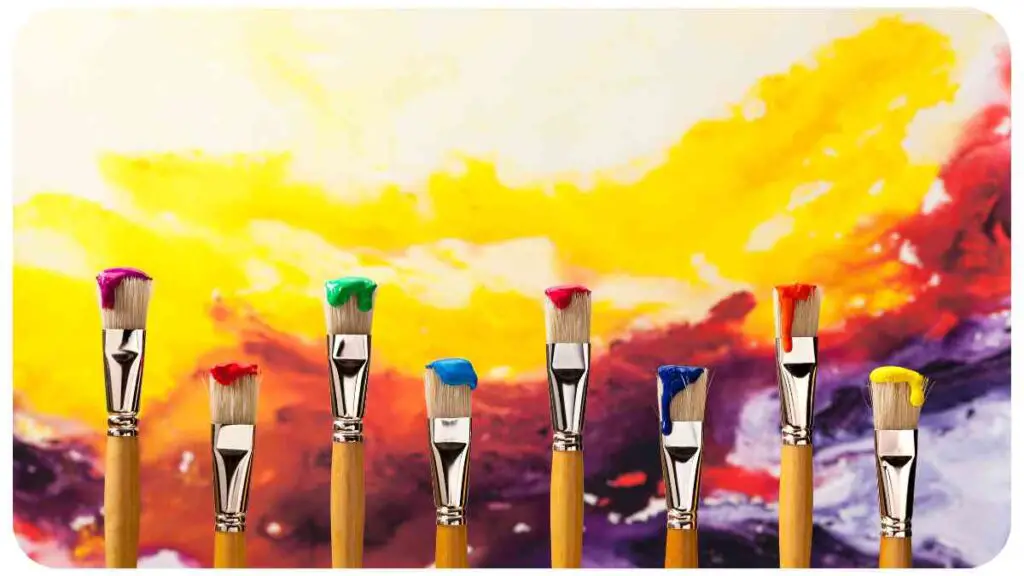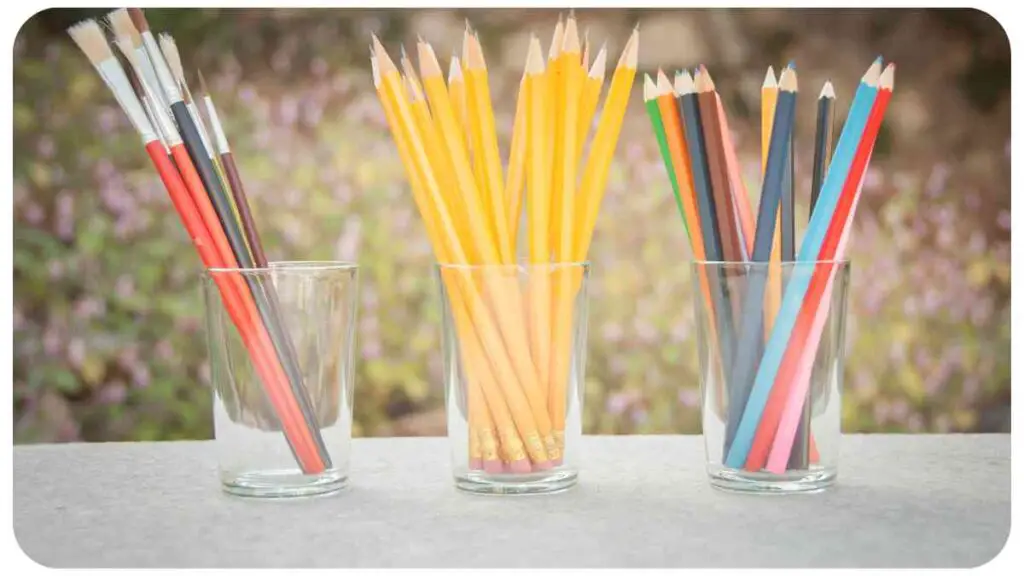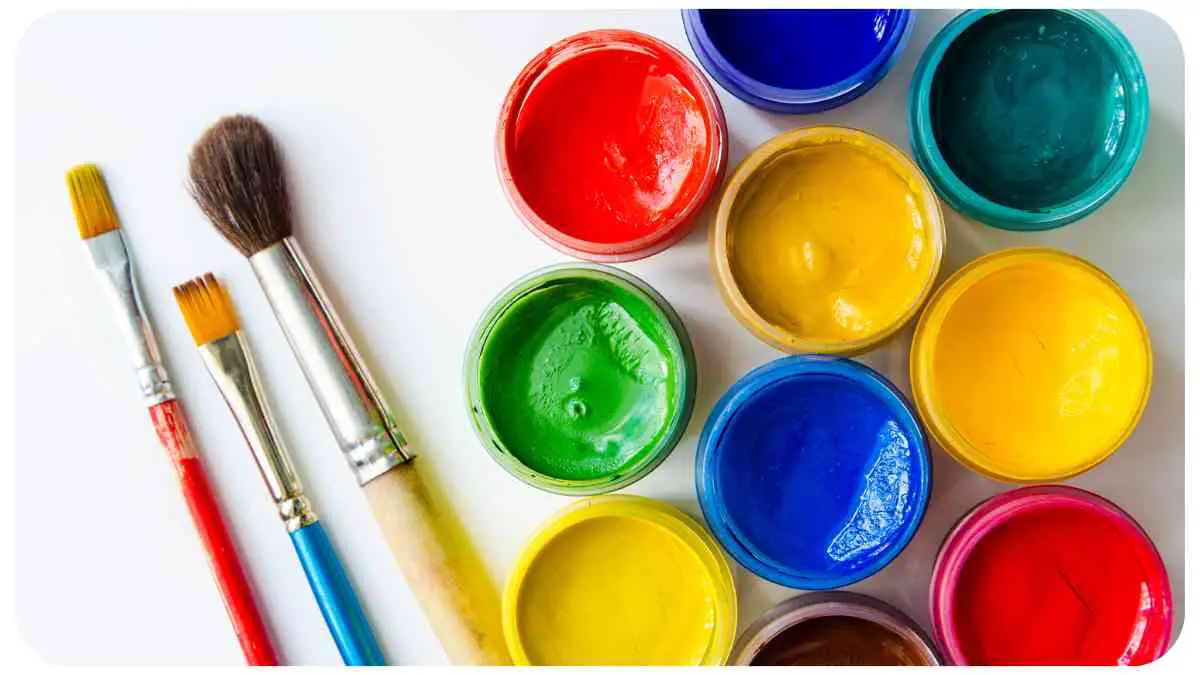As artists, we often focus on paints, canvases, and artistic techniques, but we may overlook the significance of the humble paintbrush. Can a paintbrush truly affect the outcome of our artwork? In this article, we will delve into the possibilities, exploring the role of different brush types, sizes, and shapes.
We will also discuss various painting mediums and their interaction with different brush materials. So, let’s take a brush in hand and dive into the fascinating world of brushwork and its impact on our artwork.
| Takeaways |
|---|
| Selecting the right brush is crucial for achieving desired artistic effects. |
| Consider your painting style and medium compatibility when choosing brushes. |
| Invest in high-quality brushes for better control, durability, and optimal paint application. |
| Proper care and maintenance of brushes can extend their lifespan and performance. |
| Brush quality alone does not guarantee great artwork; artistic skill and technique are key. |
Understanding the Role of a Paintbrush

The paintbrush is not merely a tool but an extension of the artist’s creativity. It allows for the precise application of paint onto the canvas, influencing the texture, flow, and depth of the artwork. Different brush materials and designs offer unique properties that affect the outcome of each brushstroke.
Building a scrapbooking masterpiece starts with the right supplies. Discover the art of choosing the right scrapbooking supplies and create memories that last a lifetime.
The Impact of Different Brush Types
When it comes to brush types, there are two primary categories: synthetic brushes and natural hair brushes. Within these categories, specific brush types such as bristle brushes and sable brushes offer distinct advantages and characteristics.
3.1 Synthetic Brushes
Synthetic brushes are made from nylon or polyester, offering a durable and versatile option for artists. They are often the preferred choice for acrylic paints due to their ability to withstand the harshness of these paints. Synthetic brushes can be used with other mediums as well but may not provide the same level of control and finesse as their natural hair counterparts.
| Brush Type | Features |
| Synthetic Brushes | – Durable and long-lasting\n- Suitable for acrylic paints |
| – Less control and finesse compared to natural hair brushes |
3.2 Natural Hair Brushes
Natural hair brushes are made from animal hair, such as hog bristles, squirrel hair, or sable hair. These brushes offer excellent absorbency and release of paint, making them ideal for oil and watercolor paints. Natural hair brushes provide greater control and responsiveness, allowing for exquisite detailing and blending techniques.
| Brush Type | Features |
| Natural Hair Brushes | – Offers better control and responsiveness |
| – Ideal for oil and watercolor paints | |
| – Includes hog bristle, squirrel hair, or sable hair |
3.3 Bristle Brushes
Bristle brushes, typically made from hog hair, are widely used for oil painting. They possess stiff and coarse bristles that allow for heavier paint application, creating bold and textured brushstrokes. Bristle brushes work exceptionally well for impasto techniques, where thick layers of paint are added to the canvas.
| Brush Type | Features |
| Bristle Brushes | – Stiff and coarse bristles\n- Ideal for oil painting\n- Creates bold strokes |
3.4 Sable Brushes
Sable brushes, made from the hair of the sable or similar animals, are prized for their softness and ability to hold and release paint smoothly.
They are favored by watercolor artists for their precise control and exceptional liquid retention. Sable brushes offer sensitivity and are suitable for fine detailing and delicate washes.
| Brush Type | Features |
| Sable Brushes | – Soft bristles |
| – Perfect for watercolor painting\n- Allows for precise control and washes |
Brush Sizes and Shapes
The size and shape of a brush play a crucial role in achieving desired artistic effects. Artists often possess an array of brushes in different sizes and shapes to cater to their specific needs. Let’s take a look at some common brush sizes and shapes:
| Brush Size | Description |
| 0 | Very fine tip, suitable for intricate details |
| 2 | Fine tip, great for detailed work |
| 4 | Small tip, ideal for small to medium-sized areas |
| 6 | Medium tip, versatile for various painting techniques |
| 8 | Large tip, suitable for broader strokes and coverage |
| 10 | Extra-large tip, perfect for large areas and washes |
Different brush shapes also offer distinct possibilities. Here are some commonly used brush shapes:
| Brush Shape | Description |
| Flat | Straight-edged brush that allows for precise strokes and coverage |
| Round | Versatile brush with a round tip, suitable for detailed work and creating thin or thick lines |
| Fan | Brush with bristles spread out in a fan shape, great for creating texture and blending |
| Filbert | Flat brush with rounded edges, perfect for blending, softening edges, and creating curved strokes |
Exploring Brush Strokes and Techniques

Mastering various brush strokes and techniques opens up a world of possibilities in creating captivating artwork. Let’s explore some popular brush strokes and their effects:
5.1 Flat Strokes
Using a flat brush, you can create broad and controlled strokes, making it suitable for covering larger areas or creating sharp edges. Flat strokes are often used in landscape paintings or when applying base colors.
Explore the world of DIY scrapbooking and unlock your creativity. Learn how to create your own albums and journals to preserve your cherished moments in style.
5.2 Round Strokes
Round brushes allow for precise control and are excellent for creating intricate details and consistent lines. They are commonly used in portraiture, botanical art, and any piece requiring fine details.
5.3 Fan Strokes
Fan brushes are unique and versatile, enabling you to create various textures, such as foliage, clouds, or hair strands. The separated bristles of a fan brush make it ideal for blending and softening edges.
5.4 Filbert Strokes
The filbert brush combines the best of flat and round brushes. Its rounded edges allow for smooth blending, while the flat surface allows for more controlled strokes. Filbert brushes are perfect for creating soft, organic forms and subtle transitions.
By mastering these brush techniques, you can add depth, texture, and visual interest to your artwork. Experiment with different strokes to discover your unique artistic style.
Exploring Different Painting Mediums
Different painting mediums interact with brushes in distinctive ways, influencing the final outcome of your artwork. Here are some insights into the relationship between brushes and various painting mediums:
6.1 Oil Paints
Oil painting requires brushes that can withstand thick and heavy paint. Bristle brushes are often the top choice for oil painting due to their stiffness and ability to handle the viscosity of oil paints. Sable brushes can also be used for finer details and glazing techniques in oil painting.
Elevate your card-making skills with expert tips and tricks. Delve into the ultimate guide to card making and turn every occasion into a work of art.
6.2 Acrylic Paints
Acrylic paints are known for their quick-drying properties and versatility. Synthetic brushes are commonly used with acrylics, as their bristles can withstand the harshness of the paint and retain their shape over time. Additionally, brushes with synthetic hair can handle the thick consistency of acrylic paints.
6.3 Watercolor Paints
Watercolors require brushes that can hold a generous amount of water and pigment while retaining their shape. Sable brushes are highly regarded for their ability to hold and release water smoothly, making them an excellent choice for watercolor painting. Synthetic brushes can also be used for watercolors, providing good water retention and control.
Choosing the Right Brush for Your Artistic Style
Selecting the right brush for your artistic style is crucial in achieving the desired effects in your artwork. Here are some considerations to keep in mind when choosing brushes:
- Painting Style: If you prefer highly detailed and precise work, round brushes with fine tips would be ideal. For broader strokes and coverage, flat brushes are a great choice. Consider the style of brushwork you typically employ and select brushes that complement it.
- Medium Compatibility: Different mediums interact differently with brushes. Consider the compatibility between the brush material and the medium you predominantly use. Synthetic brushes are well-suited for acrylic paints, while natural hair brushes are excellent for oil and watercolor paints.
- Artistic Expression: Assess the brush’s ability to achieve the desired effects and textures in your artwork. Experiment with different brush sizes and shapes to determine which ones work best for your artistic expression.
- Quality: Invest in quality brushes that will withstand frequent use and provide consistent results. High-quality brushes tend to have better bristles that retain their shape and allow for greater control. While they may be costlier, their longevity and performance will make them a worthwhile investment.
Remember, selecting the right brush is a personal choice, and what works for one artist may not work for another. Don’t be afraid to experiment and explore different brush options to find the perfect fit for your artistic journey.
Caring for Your Brushes
To ensure the longevity and performance of your brushes, proper care and maintenance are essential. Here are some tips for keeping your brushes in top condition:
Unleash your imagination without breaking the bank. Discover budget-friendly ideas for your next project with paper crafts on a budget and delve into the world of affordable creativity.
8.1 Cleaning and Maintenance
- Clean After Each Use: Rinse your brushes thoroughly with water immediately after use to remove any paint residue. For oil paints, use an appropriate solvent such as mineral spirits or odorless turpentine.
- Gentle Cleansing: Use a mild soap or brush cleaner designed specifically for artist brushes. Gently lather the bristles and rinse thoroughly until the water runs clear.
- Reshape the Bristles: After cleaning, gently reshape the bristles with your fingers to restore their original form. Avoid twisting or pulling on the bristles, as this may damage them.
8.2 Proper Storage

- Horizontal Storage: Store your brushes horizontally or in a brush roll to prevent the bristles from bending or warping.
- Protective Covers: For long-term storage or when traveling, consider using protective covers to shield the brush bristles from damage.
- Avoid Extreme Temperatures: Store brushes in a cool, dry place away from extreme temperatures, as extreme heat or cold can damage the bristles.
By incorporating regular cleaning and proper storage techniques, you can extend the lifespan of your brushes and maintain their performance over time.
The Impact of Brush Quality on Artistic Results
The quality of your brushes can significantly impact the overall outcome of your artwork. Here are some reasons why investing in high-quality brushes is important:
- Control and Precision: High-quality brushes typically have well-designed bristles that allow for better control and precision in your brushwork. This is especially crucial when working on detailed areas or intricate designs.
- Durability: Quality brushes are made with durable materials that can withstand repeated use and maintain their shape for longer periods. They are less likely to shed bristles or become frayed, ensuring consistent performance over time.
- Optimal Paint Application: Brushes of higher quality tend to hold more paint and evenly release it onto the canvas. This allows for smoother and more consistent application of paint, resulting in enhanced color saturation and blending capabilities.
- Improved Texture and Stroke Variation: Superior brushes offer a wider range of stroke variation and texture possibilities. With well-designed bristles, you can achieve a variety of brushstrokes, from crisp lines to soft blends, adding depth and dimension to your artwork.
- Long-term Investment: While high-quality brushes may be more expensive upfront, they are an investment in your artistic practice. They tend to last longer and retain their performance, ultimately saving you money in the long run.
Remember that brush quality alone does not guarantee great artwork. It is still vital to explore different brush techniques, experiment with various strokes, and develop your artistic skills. However, using quality brushes can undoubtedly enhance and elevate your artistic results.
Personal Tips and Expert Insights
As a professional artist with experience in the field, I have gathered some insights and practical tips that may benefit artists at any stage of their creative journey. Here are a few:
- Experiment and Explore: Don’t be afraid to try new brushes or techniques. Embrace the process of exploration and discovery in your artistic practice to expand your skills and find your unique style.
- Invest in a Range of Brushes: Building a collection of various brush sizes, shapes, and materials allows for greater artistic versatility. Having an assortment of brushes at your disposal enables you to achieve different effects and unleash your creativity.
- Take Care of Your Brushes: Properly cleaning and storing your brushes will prolong their lifespan and ensure optimal performance. Treat your brushes as valuable tools and give them the care they deserve.
- Learn From Other Artists: Engage with the artistic community and learn from fellow artists. Attend workshops, join art groups, and participate in exhibitions to broaden your perspective and gain inspiration from the experiences of others.
- Embrace the Imperfections: Art is not always about achieving perfection. Embrace the unique marks and textures created by your brushes. Sometimes, the most captivating and emotive artwork arises from embracing imperfections.
Remember, every artist’s journey is unique, and it is through practice, persistence, and continuous learning that you will continually grow and evolve as an artist. Trust your instincts, experiment, and enjoy the creative process.
Embark on a quilting journey and learn the art of creating beautiful quilts. Explore the ultimate guide to quilting and discover the techniques, patterns, and inspiration needed to craft your own textile masterpieces.
Conclusion
The paintbrush is more than just a tool; it is a conduit for an artist’s vision and expression. This article has explored the possibilities of how a paintbrush can affect your artwork. We delved into the impact of different brush types, sizes, and shapes, as well as their interaction with various painting mediums.
We discussed the importance of choosing the right brushes, caring for them, and understanding the significance of brush quality. Furthermore, we provided personal tips and expert insights to enrich your artistic journey.
Remember, as an artist, your paintbrush is an extension of yourself. Embrace the possibilities, experiment fearlessly, and let your unique artistic voice shine through every brushstroke. Happy creating!
Further Reading
Here are some additional resources to explore the topic of brushes and their impact on artwork:
Does the type of brush an artist uses affect the quality of their painting? (Quora): This Quora thread discusses the influence of brush types on the quality of an artist’s painting. You can find insights and perspectives from various artists on this topic.
Benefits of Painting for Children (Empowered Parents): This article highlights the benefits of painting for children, including how it enhances their creativity, improves fine motor skills, and fosters self-expression.
Natural Brushes or Synthetic Brushes: What’s the Difference and Which is Right for You? (Trekell): Trekell’s blog post provides an in-depth comparison between natural and synthetic brushes. It explores the characteristics, advantages, and considerations when choosing between these brush types.
FAQs
Why is the type of brush important in painting?
The type of brush used in painting can significantly affect the quality and outcome of the artwork. Different brush types offer unique characteristics, such as shape, bristle type, and flexibility, which influence the precision, control, and texture in an artist’s work.
Are natural brushes better than synthetic brushes?
Natural brushes typically offer better paint load, blending capabilities, and softness, making them well-suited for certain techniques and mediums. On the other hand, synthetic brushes are more durable, easier to clean, and can excel in applications such as acrylic painting. The choice between natural and synthetic brushes depends on the artist’s preferences, medium, and desired artistic effects.
How do I choose the right brush size for my artwork?
Choosing the right brush size depends on the scale of your artwork and the level of detail you want to achieve. For broader strokes and coverage, larger brush sizes are suitable, while smaller brush sizes are ideal for intricate details and precise work. It is beneficial to have a range of brush sizes available and experiment to find the right one for each specific task.
How can I extend the lifespan of my brushes?
To extend the lifespan of your brushes, ensure proper cleaning after each use, using mild soap or brush cleaners. Gently reshape the bristles and store brushes horizontally or in a brush roll to avoid bending or warping. Additionally, avoid using brushes with mediums they are not designed for, as it can damage the bristles.
Can I apply different techniques using the same brush?
Yes, you can apply different techniques using the same brush. The paint application, pressure, angle, and stroke variations can alter the visual effects and textures achieved with a single brush. Experimenting with different brush techniques and exploring the possibilities can help you discover new ways to manipulate your brushes for diverse artistic results.

Hellen James is the creator of Unified Crafts and has been crafting since she was a kid accompanied by her mom to the craft store, where she was free to choose whatever ignited her imagination.

